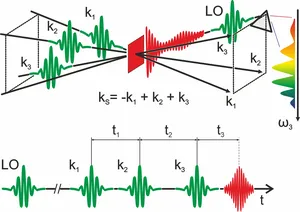
Two-dimensional electronic spectroscopy
In transient absorption (TA), the probe spectrum is dispersed in frequency, but the exciting pump spectrum is not. Detecting molecular dynamics for different excitation wavelengths can be extremely insightful, especially for biological light harvesters and their congested absorption spectra. Two-dimensional electronic spectroscopy (2D-ES) solves this problem elegantly by splitting the excitation event into two pulses, separated by time delay t1. Fourier transformation from t1 to ω1 gives the desired excitation frequency resolution while keeping the time resolution fixed by the duration of the excitation pulses.
With 2D-ES we
- Disentangle energy transfer networks in natural and artificial light-harvesting systems.
- Pinpoint the origin of wavepacket motion to either electronic ground- or excited state.
Involved group members

Alina Bach
alina.bach@tum.de

Ajeet Kumar
ajeet.kumar@tum.de
Further reading
Jonas, D. M. Two-dimensional femtosecond spectroscopy. Annu. Rev. Phys. Chem. 2003, 54, 425-463. DOI: 10.1146/annurev.physchem.54.011002.103907.
Brixner, T.; Mancal, T.; Stiopkin, I. V.; Fleming, G. R. Phase-Stabilized Two-Dimensional Electronic Spectroscopy. J. Chem. Phys. 2004, 121 (9), 4221-4236. DOI: 10.1063/1.1776112.
Own work
Milota, F.; Prokhorenko, V. I.; Mančal, T.; von Berlepsch, H.; Bixner, O.; Kauffmann, H. F.; Hauer, J. Vibronic and Vibrational Coherences in Two-Dimensional Electronic Spectra of Supramolecular J-Aggregates. J. Phys. Chem. A 2013, 117 (29), 6007-6014. DOI: 10.1021/jp3119605.
Heshmatpour, C.; Malevich, P.; Plasser, F.; Menger, M.; Lambert, C.; Šanda, F.; Hauer, J. Annihilation Dynamics of Molecular Excitons Measured at a Single Perturbative Excitation Energy. The Journal of Physical Chemistry Letters 2020, 11 (18), 7776-7781. DOI: 10.1021/acs.jpclett.0c02141.
